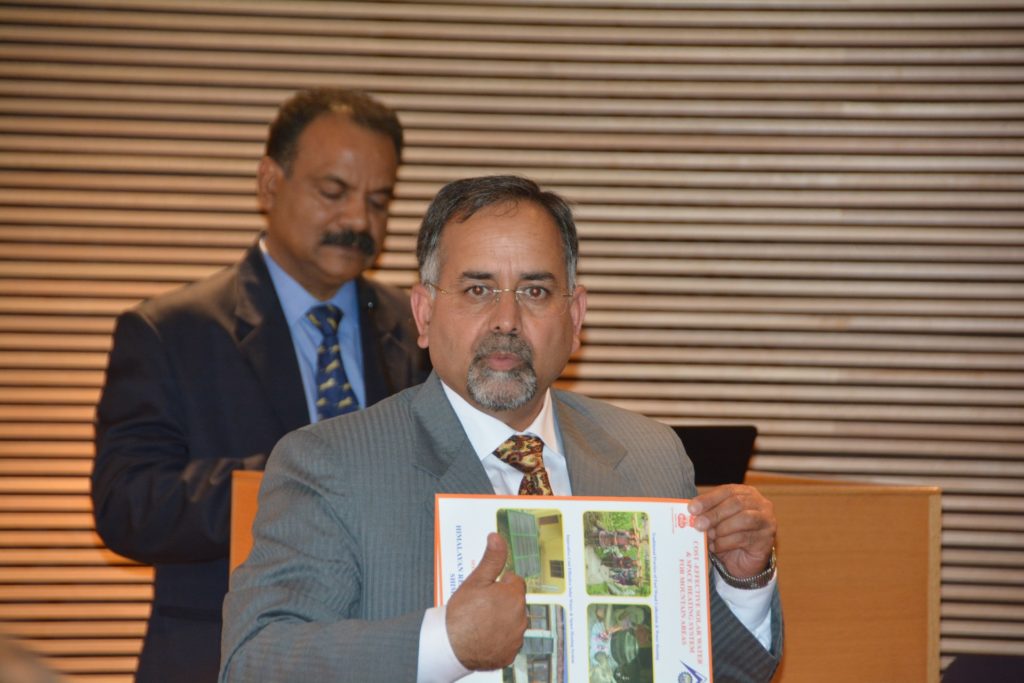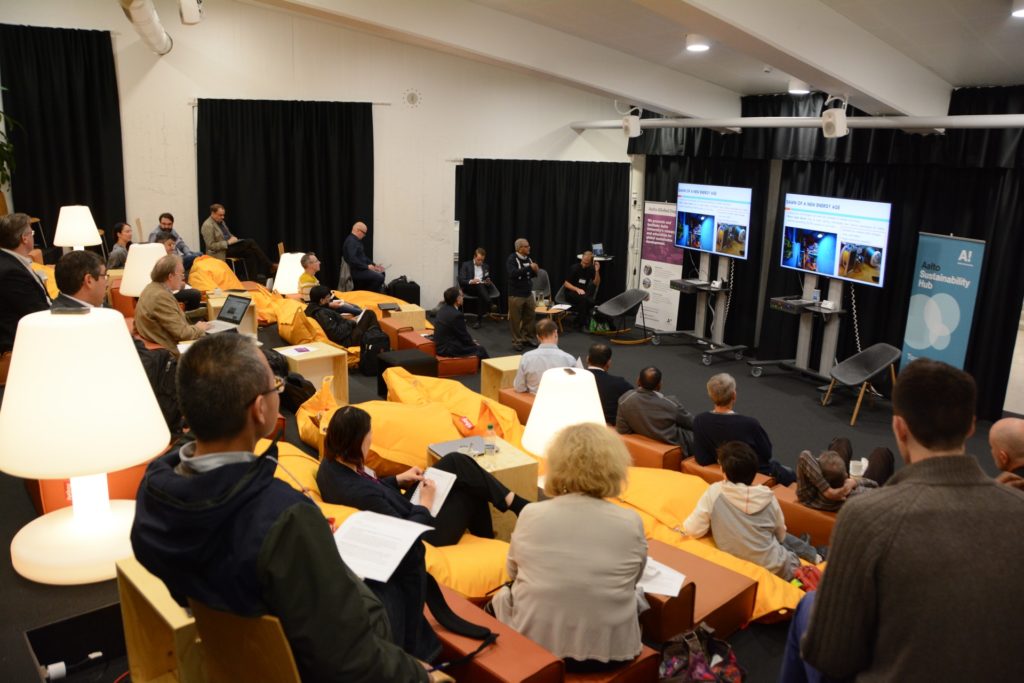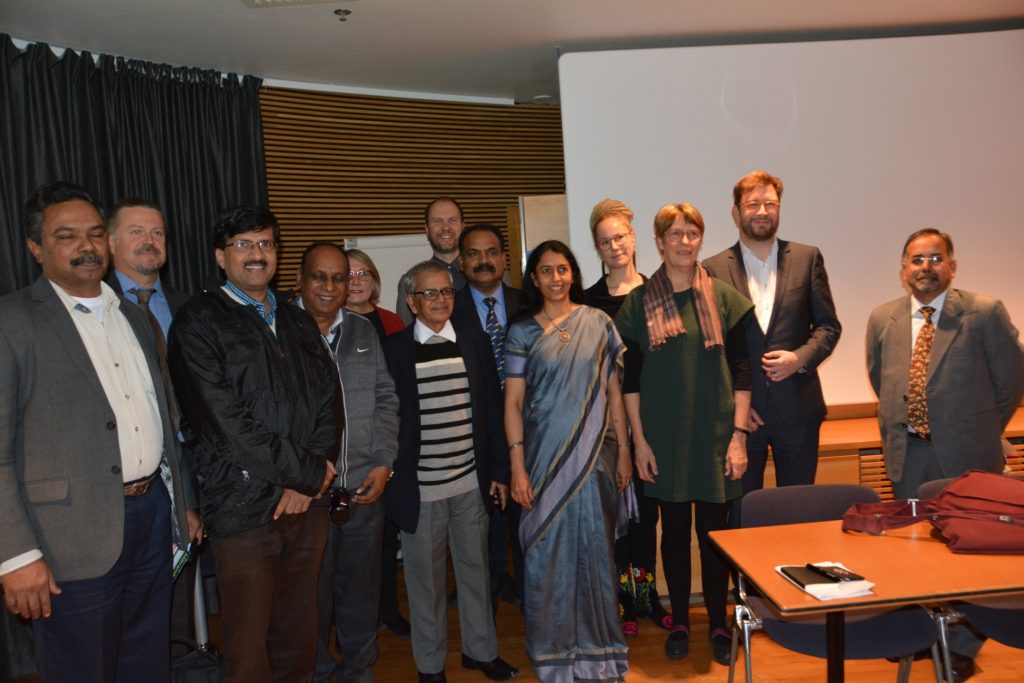[Risto Isomäki] The International Solar Innovations Council (InSIC), a new international solar energy organization, organized its second major event in Finland, in Helsinki and Espoo, during 15-18 October, 2018. The event was participated by approximately 150 people from 14 different countries, and consisted of three separate seminars and two InSIC working meetings. One of the seminars was organized together with Finnish development NGOs, at the Fingo (Kepa) headquarters. Another was a joint effort with the Aalto University Sustainability Hub in the Aalto University campus and the third seminar took place in the Finnish Parliament, in cooperation with Siemenpuu Foundation and the inter-party energy reform group and inter-party group for global affairs of the Finnish Parliament.
The thirty-plus introductions in the seminars presented a wide spectrum of new ground-breaking innovations in solar energy and related fields. Some of them were high-tech and the others high-tech/low-tech hybrid innovations, geared to meet the needs of the poorest people.
India: Developing solutions for the whole Global South
According to the Finnish organizers, the event highlighted India’s already prominent and rapidly growing role in the development of high-quality but affordable (solar) technologies geared to meet the needs of the world’s three or four billion less affluent people. The organizers had tried to find exciting examples of new solar innovations from different parts of the global South but found very little compared to what was happening to India. According to them it now seems, that India has largely taken the responsibility for developing the (solar) technologies and solutions that can raise the poorer half of the world’s population out from poverty.
Among the most important new, affordable solar technologies that have recently emerged from India are micro-solar domes, cheaper solar water and domestic space heaters and new kinds of solar-powered water purifying systems for schools.

The Indian solar-powered water purifiers (pdf) designed to cater for the needs of middle-sized schools have done extremely well trials. They were developed by professor Gon Chaudhuri, the chairman of InSIC, and his colleagues in NBIRT, together with their industrial partners in India. The first 100 units have now been installed and are providing clean drinking water for 50,000 school children. The incidence of water-borne disease among them has been reduced by 72 per cent and the girls’ school drop-out ratio has declined from 46 to 14 per cent. All this has been achieved with very little money because the system only costs about €600, or €800 with a solar-powered water pump.
The material costs of equipping 100,000 schools and 30,000 other institutions in India with similar systems would only amount to €100 million, and a half a million similar solar-powered water purifiers for half a million schools in the global South could be purchased by €400 million. It now seems that the availability of clean water is a prerequisite for successful education for many kids, especially among the girls. All studies now agree that empowering and educating girls is crucially important for numerous different reasons, including population control.
In Sub-Saharan Africa, the population growth has not declined as much as governments had hoped, and it is now feared that the region’s population might grow to five or even six billion before leveling. This scenario would be a human and ecological nightmare and everything that can be done to prevent it from becoming a reality should be done. Solar-powered water purifiers might, somewhat surprisingly, offer some assistance for these efforts.
Dr Lal Singh of the Himalayan Research Group (HRG), another member of InSIC, and Dr Maninder Jeet Kaur have developed solar water heaters and solar space heaters (pdf) that can be made locally and partly from locally produced materials. In spite of their high quality HRG’s solar water heater only costs €100 and the domestic space heater only €70, which makes them attractive even for most rural households living in areas where space heating is required during the cold seasons. Dr Singh’s and Dr Kaur’s designs constitute an almost order-of magnitude improvement when compared with Chinese solar collectors, which tend to cost almost ten times as much, not to say anything about the European and North American models, which are even more expensive.

The first one thousand units are already in use, and it is hoped that they will soon be installed in all the seven million households in Indian Himalayas, and also spread to the mountainous regions in the neighboring countries. According to HRG’s research solar water and domestic space heaters can reduce the consumption of firewood by 40 per cent. This allows the trees to grow larger and absorb more carbon dioxide from the atmosphere and also reduces the amount of soot that rains on the Himalayan glaciers. For example in Tibet the soot falling on ice currently contributes 10 or 20 times more to the melting of the glaciers than the heating impact of the extra greenhouse gases in the air. The preservation of Himalayan glaciers is crucially important for the dry-season flows of Asia’s greatest rivers and for the water supply of three billion people.
In the seminar Dr Singh emphasized the importance of five planning parameters. Successful technologies must be socially acceptable, need-based, cost-effective, long-life and require the minimum amount of post-installation maintenance.
Professor Gon Chaudhuri’s Surya Jyoti micro solar domes, the original starting point of the whole InSIC network, were also discussed in the seminars. In field trials the average reduction in a household’s carbon emissions, due to the installation of a single Surya Jyoti micro solar dome, has been 27 kilograms per month. The households that were using some kerosene and electricity to produce lighting have saved on average 10 euros per month, which means that a Surya Jyoti costing 25 euros has paid its purchase price back more than four times during one year. In the future the equation will become even better, because the price of the Surya Jyoti package is expected to drop to around 10 euros when the real mass production phase will be reached.
The new models are also equipped with a lead which enables the charging of mobile phones with Surya Jyoti’s small solar panels or batteries. The same leads could also be used to power the small electric fans of the most advanced and clean-burning biomass cooking stoves.
According to World Health Organization, small particle emissions and other pollutants produced by the world’s 400 million traditional biomass cooking stoves cause approximately 4.3 million premature deaths, every year. Besides this, the traditional biomass cooking stoves are responsible for a significant percentage of global soot emissions, and other emissions with a direct or indirect global warming impact, like carbon monoxide, nitrous oxide, methane, ozone and free hydrogen. The particle emissions of biomass stoves could be reduced by roughly one hundred times if the traditional cooking stoves were replaced by advanced models equipped with small electric fans. For example ARTI in Pune, Maharashtra, and Aprovecho in Oregon, USA have developed affordable, good-quality designs. However, their fans require 0.5 – 4 Watts of electric power which is a problem for the poorest households that have no grid connection. The solar panels and batteries of the Surya Jyotis could perhaps solve this part of the problem.
Another new innovation is a micro solar dome -equipped rural toilet. Lighting around the rural toilets is important because it makes women less vulnerable for sexual violence and because it greatly reduces the risk of snake bites. Approximately 50 per cent of all snake bites happen in rural toilets or near them. This makes a MSD-equipped dry toilet a potentially life-saving device: according to World Health Organization snake bites annually cause up to 138,000 deaths and at least three times as many amputations. Other researchers have proposed even higher figures.
Emerging new technologies could also play a role
Also in the seminar organized together with the Aalto University Sustainability Hub, a large number of exciting new technologies were introduced.
One of the speakers was David Brown, CEO of Broadbit Batteries, the company which may be able to bring the first high-performing sodium battery into the market. Still a few years ago nobody had been able to make a sodium battery that could be charged more than fifty times. Broadbit Batteries has already achieved 250 reloads and is likely to reach the level of “thousands of reloading cycles” within a couple of years. This would really change the name of the game in the field of battery technology, because there is no shortage of sodium in the world.
While the price of lithium has sky-rocketed to €12,000 per ton, sodium is a waste matter that can be acquired with a negative cost. In other words, with sodium batteries there would be virtually unlimited scalability. Broadbit’s sodium batteries can be recharged in half an hour, which is a major benefit over lithium and lead. Moreover, they already have an energy density of 300 Watt-hours per kilogram and might be able to raise to 400 Wh/kg. The maximum currently achieved by lithium batteries is around 250 Wh/kg, while 100 – 150 Wh/kg is the more common standard.

Dr Syed Ghufran Hashmi, a Pakistani scientist who has been living in Finland for ten years, presented his project on cheap and printable perovskite solar cells. Many experts have said that perovskite cells will be the future of solar power, because they can be manufactured cheaply outside a vacuum and because their raw materials are very cheap and abundant. It would probably be possible to print perovskite solar cells like the pages of a book or to spray or paint them on different kinds of surfaces.
The greatest problem has been that perovskite is not stable when exposed to air and moisture. Until recently no one had been able to make perovskite cells that would have lasted for more than a few hundred hours. However, Dr Hashmi’s team and at least two other research groups in Switzerland and the USA have now been able to protect perovskite solar cells in a way that seems to make them very durable. Dr Hashmi’s perovskite cells are not showing any visible signs of degradation and might actually last as long as the old-fashioned silicon solar cells. This could be a very important global “first” that might within time force the price of solar cells to new, “super-low” levels.
The third game-changing new technology presented in the seminar were the revolutionary heat-storing solutions developed by Dr Salla Puupponen and professor Ari Seppälä of the Aalto University. The solution of erythritol (a sugar alcohol) and sodium polyacrylate (a polymer), discovered by Puupponen, can store approximately 25 times more heat energy in each cubic meter than a cubic meter of water. The heat storage is created when the crystallized solution is heated to 104 degrees Celsius so that it melts. In its liquid form the solution can be stored for prolonged periods of time without any heat insulation. Even if the solution cools to minus 20 degrees Celsius, it does not lose any heat until it is re-heated again into a threshold temperature in which the solution begins to crystallize again, losing its latent heat.
Puupponen’s new phase-change-utilizing solutions may change the way we think about heating our houses, but they might also have many other uses. They could, for example, provide part of our future cooking energy. A 200 – 400 gram dose of sugar alcohol-polymer solution would contain enough latent heat energy for a typical round of cooking, to be used after the sun has set. The same portions could then be re-melted during the day time, for example with simple parabolic solar cookers, and re-used over and over again, probably thousands and thousands of times. At the moment the material costs approximately one euro per kilogram, but mass production would probably bring the costs down to an even more affordable level.
Political parties give their support for the approach
In the third INSIC side-event, taking place in the Finnish Parliament, the representatives of seven political parties, representing three-quarters of the Finnish Parliament, announced their support for increased use of solar energy.

India’s ambassador in Finland and Estonia, Ms Vani Rao, said that India is planning to increase its solar power capacity to 100 Gigawatts by 2020, and has already constructed the world’s largest solar power installation, with the capacity of 1 Gigawatt. Ms Rao also saw the establishment of ISA, the International Solar Alliance, as an important tool in promoting solar power in different parts of the world.
Mr Kimmo Tiilikainen, the Finnish Minister for Environment, Energy and Housing, mentioned that Finland’s installed solar power capacity has increased 10-fold in three years and that the global capacity is expected to increase by at least 440 Gigawatts during the next five years. Ms Satu Hassi, a prominent member of the Finnish Parliament, a former member of the European Parliament, and the chairwoman of both the inter-party group for global affairs and the environmental committee of the Finnish parliament, emphasized that energy-saving programmes and technologies are even more important in the fight against global warming than renewable energy, which is also important. Professor Gon Chaudhuri mentioned, that the average price of solar power in India had, in 2017, already dropped to US 3.6 cents per Kilowatt-hour.
Risto Isomäki, 2.11.2018
Writer is a novelist and energy activist. He is also actively involved in Siemenpuu’s thematic working group on forests and coastal ecosystems.
***
Presentations at the seminar hosted by Kepa/Fingo can be downloaded here in pdf format:
Dr. Sunil Agarwal: Technological Advancement for Rural Areas (TARA) Scheme
Dr. Yogesh Kulkarni: Using solar energy for improving livelihood in rural India – Vigyan Ashram’s experiences
Dr. Lal Singh: Innovative Solar water and space heating systems for mountains – a case study of the Indian Himalayas
Dr. Reghu Rama Das: Potentials of Solar Energy for Rural livelihoods
Sini Numminen: Is solar energy sustainable? Challenges of operating solar micro-grids in rural Uttar Pradesh (India) – a university research case study in seven villages
Eero Oksanen: Promoting solar energy in Finland
Amelie Oheim and Teresa Lopez: EKOenergy’s Climate Fund tackling poverty through supporting solar energy projects
Kari Silfverberg: What’s happening in the field of solar cookers?
Professor S.P. Gonchaudhury: How the new Indian solar energy innovations are making solar energy affordable for the billions
Programme of the seminar at the Parliament as well as photos are available at the facebook event.
Cover photo: Surya Jyoti micro solar domes are welcomed by Indian women (Photo: NBIRT)
